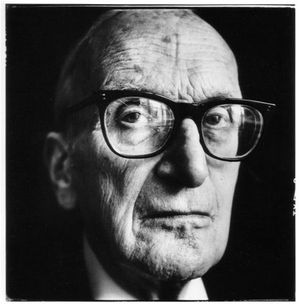Course:Law3020/2014WT1/Group E/Separation Thesis
Separation Thesis: H.L.A. Hart
While law and morality may parallel one another, they are not the same thing, as stated in the Natural law theory. HLA Hart contends that they are two different systems, but morality can be used to assess whether a law should be followed or not. There is a balancing between law being a legal rule that ought to be followed and the morality of the law. In certain cases, Hart demonstrates that sometimes a law may be completely valid and effective, but too evil or immoral for people to follow. He points to the case of the laws enacted within the Nazi regime as an example of this. Hart develops the idea of the “Rule of Recognition”, which states that for laws to be operative they must be established within a legal system and followed by some people in society for reasons other than that they would be punished for disobeying them. These reasons could be because the law is good, that people would not be serving their own self-interest if they did not follow them, or that they are simply in the habit of always following the rules.
Harts states that for a law to be valid law, it must abide by two sets of rules. The primary rules being that a law should tell us what we can and can’t do. The secondary rules are that there must be rules that govern the system that develops the laws. This, he claims, is law as a ‘rule governed practice’. The laws have ‘ought to’ claims that apply to those in society, which are similar to neural rules in sport (he compares it to the rules in baseball). These rules develop duties between people, as well as grant them rights in certain situations. The principles of justice established within a rule governed practice are made a part of the law, but can also be subject to change as things change within the system and the surrounding society.
Hart also introduces a term called ‘the penumbra’. To explain this, he begins with the notion that laws have a settled core of meaning, since laws can be expressed in general terms. But the facts of certain cases may not fall within this settled core. It is then considered to be in the penumbra. When judges are looking to decide these penumbra cases, they need to look to the terms of the rule governed practice which establishes their laws. In this way, when they are making their decision and filling in the gaps of the law, they are using the same set of principles used to develop laws in the first place. This removes any possibility of a judge letting their own personal morality or preference affect the judgement.
Application to K.L.B. v. B.C.
Morality of Law: Lon Fuller
A major critic of HLA Hart was Lon Fuller who developed his own theory known as the morality of law. Fuller does not hold the same belief as Hart, that law and morality are separate. Instead, he suggests that the two cannot exists without one another, and that morality is a crucial part of the law. He does not believe in there being a settled core of law and disregards the concept of the penumbra
8 ways to make law fail
- When decisions are ad hoc – arbitrary and random
- Where rules are not public, knowable
- The abuse of retroactive legislation
- Where rules are not understandable
- Where rules are contradictory
- Where rules cannot be obeyed (obeying them beyond person’s ability)
- Very frequent changing of rules (so person cannot orient their behaviour by them)
- Disjunction between rules as rules and rules as actually administered by judges

